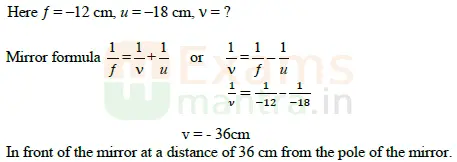Boost your exam preparation with the Class 10 Science 086 Previous Year Question Paper 2024 Set 1 with Solution. This paper is based on the latest CBSE guidelines and covers all key topics from Physics, Chemistry, and Biology. Solving it helps students understand the exam pattern, question types, and marking scheme while improving accuracy and speed.
For students and teachers, it’s a great way to revise concepts, identify weak areas, and practice time management before the pre-board and board exams and serves as a ready resource to conduct practice sessions, prepare assignments, and guide students with effective exam strategies resepectively. Regular practice with such solved sample papers and previous year QPs not only boosts confidence but also ensures a better grasp of concepts, leading to improved performance in the final examination.
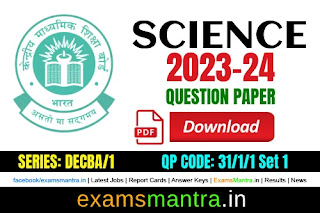
Series DECBA/1
Question Paper Code 31/1/1 Set 1
CLASS 10 SCIENCE PREVIOUS YEAR QUESTION PAPER
(Session 2023-24)
Time allowed : 3 hours
Maximum Marks : 80
General Instructions :Read the instructions very carefully and strictly follow them:
1. This question paper comprises 39 questions. All questions are compulsory.
2. The question paper is divided into five sections – A, B, C, D and E
3. Section A – Question Nos. 1 to 20 are multiple choice questions. Each question carries 1 mark.
4. Section B – Question Nos. 21 to 26 are very short answer type questions. Each question carries 2 marks. Answer these questions should be in the range of 30 to 50 words.
5. Section C – Question Nos. 27 to 33 are short answer type questions. Each question carries 2 marks. Answer these questions should be in the range of 50 to 80 words.
6. Section D – Question Nos. 34 to 36 are long answer type questions. Each question carries 2 marks. Answer these questions should be in the range of 80 to 120 words.
7. Section E – Question Nos. 37 to 39 are of 3 source-based/case-based units of assessment carrying 4 marks each with sub-parts.
8. There is no overall choice. However, an internal choice has been provided in some sections. Only one of the alternatives has to be attempted in such questions.
SECTION – A
Select and write the most appropriate option out of the four options given for each of the questions 1-20. There is no negative mark for the incorrect response.
1. When 2 mL of sodium hydroxide solution is added to few pieces of granulated zinc in a test tube and then warmed, the reaction that occurs can be written in the form of a balanced chemical equation as:
(a) NaOH + Zn → NaZnO2 + H2O
(b) 2NaOH + Zn → Na2ZnO2 + H2
(c) 2NaOH + Zn → NaZnO2 + H2
(d) 2NaOH + Zn → Na2ZnO2 + H2O
2. Select from the following a decomposition reaction in which source of energy for decomposition is light:
(a) 2FeSO4 → Fe203 + SO2 + SO3
(b) 2H2O → 2H2 + O2
(c) 2AgBr → 2Ag + Br2
(d) CaCO3 → CaO + CO2
3. A metal and a non-metal that exists in liquid state at the room temperature are respectively:
(a) Bromine and Mercury
(b) Mercury and Iodine
(c) Mercury and Bromine
(d) Iodine and Mercury
4. Carbon compounds:
(i) are good conductors of electricity.
(ii) are bad conductors of electricity.
(iii) have strong forces of attraction between their molecules.
(iv) have weak forces of attraction between their molecules.
The correct statements are:
(a) (i) and (ii)
(b) (ii) and (iii)
(c) (ii) and (iv)
(d) (i) and (iii)
5. Consider the following compounds:
FeSO4 ; CuSO4 ; CaSO4 ; Na2CO3
The compound having maximum number of water of crystallisation in its crystalline form in one molecule is:
(a) FeSO4
(b) CuSO4
(c) CaSO4
(d) Na2CO3
6. Oxides of aluminium and zinc are:
(a) acidic
(b) basic
(c) amphoteric
(d) neutral
7. MnO2 + 4HCl → MnCl2 + 2H2O + Cl2
The reaction given above is a redox reaction because in this case:
(a) MnO2 is oxidised and HCl is reduced
(b) HCl is oxidised
(c) MnO2 is reduced
(d) MnO2 is reduced and HCl is oxidised
8. Consider the following statements:
(i) The sex of a child is determined by what it inherits from the mother.
(ii) The sex of a child is determined by what it inherits from the father.
(iii) The probability of having a male child is more than that of a female child.
(iv) The sex of a child is determined at the time of fertilisation when male and female gametes fuse to form a zygote.
The correct statements are:
(a) (i) and (iii)
(b) (ii) and (iv)
(c) (iii) and (iv)
(d) (i), (iii) and (iv)
9. Chromosomes:
(i) carry hereditary information from parents to the next generation.
(ii) are thread like structures located inside the nucleus of an animal cell.
(iii) always exist in pairs in human reproductive cells.
(iv) are involved in the process of cell division.
The correct statements are:
(a) (i) and (ii)
(b) (iii) and (iv)
(c) (i), (ii) and (iv)
(d) (i) and (iv)
10. In a nerve cell, the site where the electrical impulse is converted into a chemical signal is known as:
(a) Axon
(b) Dendrites
(c) Neuromuscular junction
(d) Cell body
11. A stomata closes when:
(i) it needs carbon dioxide for photosynthesis.
(ii) it does not need carbon dioxide for photosynthesis.
(iii) water flows out of the guard cells.
(iv) water flows into the guard cells.
The correct reason(s) in this process is/are:
(a) (i) only
(b) (i) and (iii)
(c) (ii) and (iii)
(d) (ii) and (iv)
12. At what distance from a convex lens should an object be placed to get an image of the same size as that of the object on a screen?
(a) Beyond twice the focal length of the lens
(b) At the principal focus of the lens
(c) At twice the focal length of the lens
(d) Between the optical centre of the lens and its principal focus
13. The lens system of human eye forms an image on a light sensitive screen, which is called as:
(a) Cornea
(b) Ciliary muscles
(c) Optic nerves
(d) Retina
14. The pattern of the magnetic field produced inside a current carrying solenoid is:
Ans: (a)
15. Identify the food chain in which the organisms of the second trophic level are missing:
(a) Grass, goat, lion
(b) Zooplankton, Phytoplankton, small fish, large fish
(c) Tiger, grass, snake, frog
(d) Grasshopper, grass, snake, frog, eagle
16. In which of the following organisms, multiple fission is a means of asexual reproduction?
(a) Yeast
(b) Leishmania
(c) Paramoecium
(d) Plasmodium
For Q. Nos. 17 to 20, two statements are given — One labelled as Assertion (A) and the other labelled as Reason (R). Select the correct answer to these questions from the codes (a), (b), (c) and (d) as given below:
17. Assertion (A): Hydrogen gas is not evolved when zinc reacts with nitric acid.
Reason (R): Nitric acid oxidises the hydrogen gas produced to water and itself gets reduced.
(a) Both Assertion (A) and Reason (R) are true and Reason (R) is the correct explanation of the Assertion (A)
(b) Both Assertion (A) and Reason (R) are true, but Reason (R) is not the correct explanation of the Assertion (A)
(c) Assertion (A) is true, but Reason (R) is false
(d) Assertion (A) is false, but Reason (R) is true
18. Assertion (A): Accumulation of harmful chemicals is maximum in the organisms at the highest trophic level of a food chain.
Reason (R): Harmful chemicals are sprayed on the crops to protect them from diseases and pests.
(a) Both Assertion (A) and Reason (R) are true and Reason (R) is the correct explanation of the Assertion (A)
(b) Both Assertion (A) and Reason (R) are true, but Reason (R) is not the correct explanation of the Assertion (A)
(c) Assertion (A) is true, but Reason (R) is false
(d) Assertion (A) is false, but Reason (R) is true
19. Assertion (A): The rate of breathing in aquatic organisms is much faster than in terrestrial organisms.
Reason (R): The amount of oxygen dissolved in water is very high as compared to the amount of oxygen in air.
(a) Both Assertion (A) and Reason (R) are true and Reason (R) is the correct explanation of the Assertion (A)
(b) Both Assertion (A) and Reason (R) are true, but Reason (R) is not the correct explanation of the Assertion (A)
(c) Assertion (A) is true, but Reason (R) is false
(d) Assertion (A) is false, but Reason (R) is true
20. Assertion (A): The rainbow is a natural spectrum of sunlight in the sky.
Reason (R): Rainbow is formed in the sky when the sun is overhead and water droplets are also present in air.
(a) Both Assertion (A) and Reason (R) are true and Reason (R) is the correct explanation of the Assertion (A)
(b) Both Assertion (A) and Reason (R) are true, but Reason (R) is not the correct explanation of the Assertion (A)
(c) Assertion (A) is true, but Reason (R) is false
(d) Assertion (A) is false, but Reason (R) is true
SECTION – B
Question Nos. 21 to 26 are Very Short Answer type questions. Each question carries 2 marks.
21. Name the type of chemical reaction in which calcium oxide reacts with water. Justify your answer by giving balanced chemical equation for the chemical reaction.
Ans: Combination reaction – Single product is formed (or any other)
CaO(s) [Quick lime] + H2O(l) → Ca(OH)2(aq) [Slaked lime/ Calcium hydroxide] + Heat
22. State one role of each of the following in human digestive system:
(i) Hydrochloric acid
Ans: Creates an acidic medium for facilitating the action of enzyme / kills microorganisms.
(ii) Villi
Ans: Increases the surface area for absorption of digested food.
(iii) Anal Sphincter
Ans: Exit of waste material from anus is regulated.
(iv) Lipase
Ans: Breakdown / digestion of emulsified fats or lipids
23. (A) How is the movement of leaves of a sensitive plant different from the downward movement of the roots?
| Movement of leaves of sensitive plant | Downward movement of roots |
| (i) Stimulus is touch. (ii) No growth is involved in the movement. (iii) Non directional | Stimulus is gravity. Growth is involved in the movement Directional |
OR
(B) There is a hormone which regulates carbohydrate, protein and fat metabolism in our body. Name the hormone and the gland which secretes it. Why is it important for us to have iodised salt in our diet?
Ans: Thyroxine, Thyroid gland
Iodine is necessary for thyroid gland to make thyroxine hormone. Deficiency of iodine in our diet causes goitre.
24. An object is placed at a distance of 10 cm from a convex mirror of focal length 15 cm. Find the position of the image formed by the mirror.
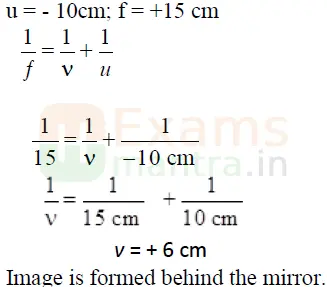
25. (A) Show how you would connect three resistors each of resistance 6𝛺, so that the combination has a resistance of 9𝛺. Also justify your answer.
Ans: When two 6𝛺 resistances are connected in parallel and the third resistance of 6𝛺 is connected in series combinations to this, then equivalent resistance will be 9𝛺.
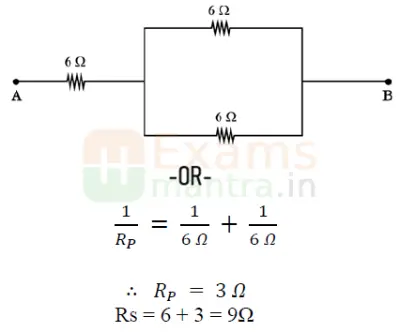
OR
(B) In the given circuit calculate the power consumed in watts in the resistor of 2 ohm:
Ans: Equivalent resistance = 𝑅1 + 𝑅2= 1𝛺 + 2𝛺 = 3𝛺
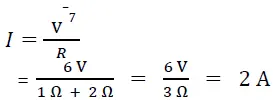
Electric power, P = I2R
= (2A)2 X 2 𝛺 = 4 X 2 W = 8 W
26. (i) Two magnetic field lines do not intersect each other. Why?
Ans: If they intersect then at the point of intersection, there would be two directions of magnetic field or compass needle would point towards two directions, which is not possible.
(ii) How is a uniform magnetic field in a given region represented? Draw a diagram in support of your answer.
Ans: Uniform magnetic field is represented by equidistant parallel straight lines.
————————→
————————→
————————→
————————→
SECTION – C
27. Write one chemical equation each for the chemical reaction in which the following have taken place:
Mention colour change/temperature change (rise/fall)/compound precipitated along with equation.
(i) Change in colour
Ans: The solution will become green in colour.
Fe(s)+ CuSO4(aq) [Blue] → FeSO4 [Green]+ Cu(s)
(ii) Change in temperature
Ans: The temperature will increase.
NaOH(aq) + HCl(aq) → NaCl(aq) + H2O(l) + Heat
(iii) Formation of precipitate
Ans: Yellow precipitate of PbI2 is formed.
Pb(NO3)2 (aq)+ 2 KI(aq) → PbI2(s) [Yellow] + 2 KNO3(aq)
28. (i) The pH of a sample of tomato juice is 4.6. How is this juice likely to be in taste? Give reason to justify your answer.
Ans: The taste of tomato juice will be slightly sour;
The pH 4.6 indicates that tomato juice is an acid and acids are sour in taste.
(ii) How do we differentiate between a strong acid and a weak base in terms of ion-formation in aqueous solutions?
Ans: Acids that give more H+ ions / H3O+ are Strong Acids.
Bases that give less OH– ions are Weak Bases.
(iii) The acid rain can make the survival of aquatic animals difficult. How?
Ans: Living animals can survive within a pH range of 7·0 to 7·8. So, if the pH of river water becomes low due to acid rain (pH < 5·6), then survival of aquatic animals becomes difficult.
29. (i) Why is respiratory pigment needed in multicellular organisms with large body size?
Ans: Diffusion /Diffusion pressure alone cannot take care of oxygen delivery to all parts of the body.
(ii) Give reasons for the following:
(a) Rings of cartilage are present in the throat.
Ans: To ensure that the air-passage does not collapse.
(b) Lungs always contain a residual volume of air.
Ans: There is sufficient time for oxygen to be absorbed and for the carbon dioxide to be released.
(c) The diaphragm flattens and ribs are lifted up when we breathe in.
Ans: Chest cavity becomes larger.
(d) Walls of alveoli contain an extensive network of blood vessels.
Ans: Because exchange of gases takes place in the alveoli.
30. Define reflex action. With the help of a flow chart show the path of a reflex action such as sneezing.
Ans: Reflex action is a sudden/spontaneous/immediate action in response to the environment/ stimulus
Stimulus → Receptors (Nose) → Sensory neuron → Spinal cord (Relay neuron) → Motor neuron → Effector (Muscles) → Response
31. Study the diagram given below and answer the questions that follow:
(i) Name the defect of vision represented in the diagram. Give reason for your answer.
Ans: Hypermetropia or Far-sightedness.
Reason – Image is formed behind the retina. / Near point for the person is farther away from the normal near point (25 cm)
(ii) List two causes of this defect.
Ans: Focal length of the eye lens is too long.
The eyeball has become too small.
(iii) With the help of a diagram show how this defect of vision is corrected.
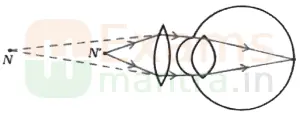
32. Name and state the rule to determine the direction of a:
(i) magnetic field produced around a current carrying straight conductor.
Ans: > Right – Hand Thumb Rule
> If the wire carrying current is held in our right hand such that the Thumb points towards the Direction of Current, then the fingers wrap around the conductor in the direction of field lines of the magnetic field.
(ii) force experienced by a current carrying straight conductor placed in a magnetic field which is perpendicular to it.
Ans: > Fleming’s Left – Hand Rule
> Stretch the thumb, forefinger and middle finger of left hand mutually perpendicular to each other, such that first finger points in the direction of Magnetic Field, second finger in the direction of Current, then thumb in the direction of motion or force acting on the conductor.
33. (A) Plants -> Deer -> Lion
In the given food chain, what will be the impact of removing all the organisms of second trophic level on the first and third trophic level? Will the impact be the same for the organisms of the third trophic level in the above food chain if they were present in a food web? Justify.
Ans: > Number of plants/organisms of first trophic level will increase.
> Number of lions/ organisms of third trophic level will decrease.
> No
> As the organisms of that level will find alternative foods and will not starve to death / food web is more stable where other animals as prey may be available.
OR
(B) A gas ‘X’ which is a deadly poison is found at the higher levels of atmosphere and performs an essential function. Name the gas and write the function performed by this gas in the atmosphere. Which chemical is linked to the decrease in the level of this gas? What measures have been taken by an international organization to check the depletion of the layer containing this gas?
Ans: > Gas ‘X’ is Ozone
> Ozone shields the surface of the earth from ultra-violet (UV) radiations from the sun.
> Succeeded in forging an agreement to freeze CFC production at 1986 levels / Manufacturing of CFC free refrigerators
> CFCs (Chlorofluorocarbons)
SECTION – D
34. (A) (i) Define a homologous series of carbon compounds.
Ans: A series of carbon compounds in which the same functional group substitutes for hydrogen in a carbon chain / Series of compounds having same functional group and similar chemical properties.
(ii) Why is the melting and boiling points of C4H8 higher than that of C3H6 or C2H4?
Ans: Because melting point and boiling point increase with molecular mass.
(iii) Why do we NOT see any gradation in chemical properties of a homologous series compounds?
Ans: Because chemical properties of organic compounds are solely determined by their functional group which remains same in a homologous series.
(iv) Write the name and structures of (i) aldehyde and (ii) ketone with molecular form C3H6O.
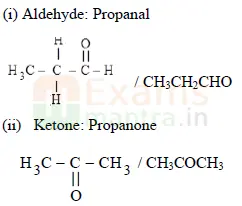
OR
(B) (i) Write the name and structure of an organic compound ‘X’ having two carbon atoms in its molecule and its name is suffixed with ‘-ol’.
(ii) What happens when ‘X’ is heated with excess concentrated sulphuric acid at 443 K? Write chemical equation for the reaction stating the conditions for the reaction. Also state the role played by concentrated sulphuric acid in the reaction.
(iii) Name and draw the electron dot structure of hydrocarbon produced in the above reaction.
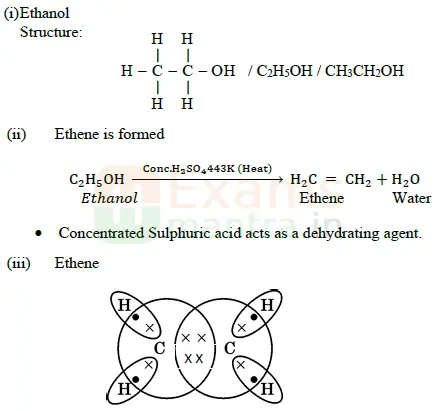
35. (A) (i) Name three techniques/devices used by human females to avoid pregnancy. Mention the side effects caused by each.
Ans: > Chemical Method/Oral pills
Side effect: Change the hormonal balance of the body.
> Barrier method / Loop / Copper–T
Side effect: Irritation in uterus.
> Surgical method / Fallopian tube in female is blocked
Side effect: may cause infections.
(ii) What will happen if in a human female:
(a) fertilisation takes place
Ans: Fertilized egg/zygote gets implanted in the lining of uterus and starts dividing.
(b) an egg is not fertilised?
Ans: If the egg is not fertilized, the thick and spongy lining of the uterus breaks and comes out through the vagina as blood and mucous.
OR
(i) Draw a diagram showing spore formation in Rhizopus and label the (a) reproductive and (b) non-reproductive parts. Why does Rhizopus not multiply on a dry slice of bread?
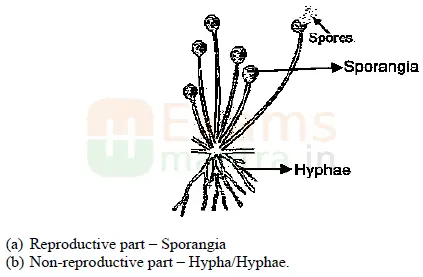
(ii) Name and explain the process by which reproduction takes place in Hydra.
Ans: Budding
Hydra uses regenerative cells for reproduction. A bud develops as an outgrowth due to repeated cell division at one specific site and develop into tiny individuals. On maturation, these buds detach from the parent and become new individuals.
Alternate Ans:
Regeneration:
It is carried out by specialised cells. If hydra is cut or broken into many pieces, many of these pieces grow into separate individuals.
36. (A) (i) Define electric power. Express it in terms of potential difference (V) and resistance (R).
Ans: Electric power: Rate at which electrical energy is dissipated or consumed / Rate of supplying energy to maintain the flow of current through a circuit.
P = V2 / R
(ii) An electric oven is designed to work on the mains voltage of 220 V. This oven consumes 11 units of electrical energy in 5 hours. Calculate:
(a) power rating of the oven
Ans: (1 unit = 1kWh)
Power, P = 𝐸𝑙𝑒𝑐𝑡𝑟𝑖𝑐𝑎𝑙 𝑒𝑛𝑒𝑟𝑔𝑦 𝑐𝑜𝑛𝑠𝑢𝑚𝑒𝑑 / 𝑇𝑖𝑚𝑒
= 11kWh / 5h
= 2.2kW or 2200 W
(b) current drawn by the oven
Ans: I = P / V
= 2200 / 220 = 10A
(c) resistance of the oven when it is red hot
Ans: R = V2 / P
= (220)2 / 2200 = 22Ω
OR
(B) (i) Write the relation between resistance R and electrical resistivity p of the material of a conductor in the shape of cylinder of length / and area of cross-section A. Hence derive the SI unit of electrical resistivity.
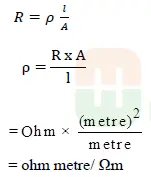
(ii) The resistance of a metal wire of length 3 m is 60 ohm. If the area of cross-section of the wire is 4×10 -7’ m2, calculate the electrical resistivity of the wire.
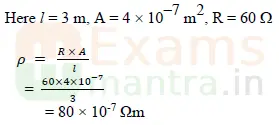
(iii) State how would electrical resistivity be affected if the wire (of part ‘ii’) is stretched so that its length is doubled. Justify your answer.
Ans: Resistivity will not change. Because Resistivity does not depend on the dimension of the conductor / It only depends on the nature of the material.
SECTION – E
Q. Nos. 37-39 are source-based/case-based questions with 2 to 3 short sub- parts. Internal choice is provided in one of these sub-parts:
37. The metals produced by various reduction processes are not very pure. They contain impurities, which must be removed to obtain pure metals. The most widely used method for refining impure metals is electrolytic refining.
(i) What is the cathode and anode made of in the refining of copper by this process?
Ans: Cathode – Pure copper
Anode – Impure copper
(ii) Name the solution used in the above process and write its formula.
Ans: Acidified Copper Sulphate; CuSO4
(iii) (A) How copper gets refined when electric current is passed in the electrolytic cell?
Ans: Pure copper from the anode dissolves into electrolyte and an equivalent amount of pure metal from the electrolyte is deposited on cathode.
At anode : Cu → Cu++ + 2e–
At cathode : Cu++ + 2e– → Cu [Pure]
The soluble impurities go into the solution whereas insoluble impurities settle down at the bottom of the anode.
OR
(iii) (B) You have two beakers ‘A’ and ‘B’ containing copper sulphate solution. What would you observe after about 2 hours if you dip a strip of zinc in beaker ‘A’ and a strip of silver in beaker ‘B’? Give reason for your observations in each case.
Ans: In Beaker A: The blue colour of the solution fades (or becomes colourless)
Reason: Zn is more reactive than copper
In Beaker B: No change in colour
Reason: Silver is less reactive than Copper
38. Mendel worked out the rules of heredity by working on garden pea using a number of visible contrasting characters. He conducted several experiments by making a cross with one or two pairs of contrasting characters of pea plant. On the basis of his observations he gave some interpretations which helped to study the mechanism of inheritance.
(i) When Mendel crossed pea plants with pure tall and pure short characteristics to produce F, progeny, which two observations were made by him in F, plants?
Ans: > In F1 generation, all plants were tall / No short plants were observed.
> No medium height plants / No halfway characteristics were observed / Only dominant parental traits were seen and not the mixture of the two.
(ii) Write one difference between dominant and recessive trait.
| Dominant trait | Recessive trait |
| Single copy of dominant trait is enough to get it expressed/always expressed | Only expressed when present in pair. |
(iii) (A) Ina cross with two pairs of contrasting characters
RRYY X rryy
(Round Yellow) (Wrinkled Green)
Mendel observed 4 types of combinations in F2 generation. By which method did he obtain F1 generation? Write the ratio of the parental combinations obtained and what conclusions were drawn from this experiment.
Ans: > Self-pollination / Self-fertilisation / Selfing of F1 plants
> Ratio – Round Yellow : Wrinkled Green (9 : 1)
> Traits are inherited independently.
OR
(iii) (B) Justify the statement:
“Tt is possible that a trait is inherited but may not be expressed.”
Ans: If pea plants with yellow seeds are crossed with plants of green seeds, it is found that in F1 generation all the plants have yellow seeds. When F1 plants are self-pollinated, it is found that in F2 generation, plants with yellow seeds and plants with green seeds are obtained. This shows that both the traits are inherited but only one trait is visible in F1 progeny while the other remains unexpressed.
39. Study the data given below showing the focal length of three concave mirrors A, B and C and the respective distances of objects placed in front of the mirrors :
| Case | Mirror | Focal length (cm) | Object Distance (cm) |
| 1 | A | 20 | 45 |
| 2 | B | 15 | 30 |
| 3 | C | 30 | 20 |
(i) In which one of the above cases the mirror will form a diminished image of the object? Justify your answer.
Ans: Mirror A. As the object is placed beyond the centre of curvature of the mirror.
(ii) List two properties of the image formed in case 2.
Ans: Same size/ Real / Inverted
(iii) (A) What is the nature and size of the image formed by mirror C? Draw ray diagram to justify your answer.
Ans: Nature-Virtual and erect
Size-magnified
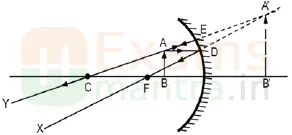
OR
(iii) (B) An object is placed at a distance of 18 cm from the pole of a concave mirror of focal length 12 cm. Find the position of the image formed in this case.
